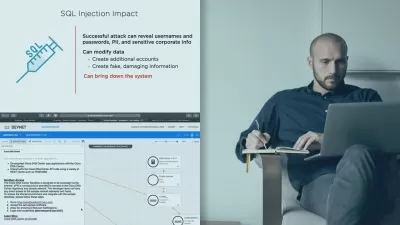NIST Cyber Security Framework
Michael Goedeker
2:58:29
Description
An introduction and look at the Cyber Security Framework and its Controls.
What You'll Learn?
- Understand what NIST Cyber Security Framework (CSF)is and how it was created
- Understand the components of NIST CSF
- Understand the NIST CSF Areas
- Look at the individual NIST CSF Categories and Sub-Categories
- Understand how to implement NIST CSF and do a Self-Assessment
- Learn about the challenges and advantages of implementing NIST CSF
Who is this for?
What You Need to Know?
More details
DescriptionUnderstanding what the NIST Cybersecurity Framework is helps us to decide whether it’s the right framework for us. If we look at what NIST says the CSF is we read the following:
Building from those standards, guidelines, and practices, the Framework provides a common taxonomy and mechanism for organizations to:
1. Describe their current cybersecurity posture;
2. Describe their target state for cybersecurity;
3. Identify and prioritize opportunities for improvement within the context of a continuous and repeatable process;
4. Assess progress toward the target state;
5. Communicate among internal and external stakeholders about cybersecurity risk.
The Framework is not a one-size-fits-all approach to managing cybersecurity risk for critical infrastructure. Organizations will continue to have unique risks – different threats, different vulnerabilities, different risk tolerances. They also will vary in how they customize practices described in the Framework. Organizations can determine activities that are important to critical service delivery and can prioritize investments to maximize the impact of each dollar spent. Ultimately, the Framework is aimed at reducing and better managing cybersecurity risks.
This course will focus on the 5 Areas, Categories and Sub Categories of each area, we then work our way through the whole framework to then discuss the Pros and Cons of the CSF and how to implement it in a project at your company or for your company / team / department.
Who this course is for:
- Anyone who wants to understand cybersecurity standards
- Anyone who wants to understand what NIST CSF is
- Implement CSF controls in an organization
- Learn about the challenges and advantages of using the NIST CSF
Understanding what the NIST Cybersecurity Framework is helps us to decide whether it’s the right framework for us. If we look at what NIST says the CSF is we read the following:
Building from those standards, guidelines, and practices, the Framework provides a common taxonomy and mechanism for organizations to:
1. Describe their current cybersecurity posture;
2. Describe their target state for cybersecurity;
3. Identify and prioritize opportunities for improvement within the context of a continuous and repeatable process;
4. Assess progress toward the target state;
5. Communicate among internal and external stakeholders about cybersecurity risk.
The Framework is not a one-size-fits-all approach to managing cybersecurity risk for critical infrastructure. Organizations will continue to have unique risks – different threats, different vulnerabilities, different risk tolerances. They also will vary in how they customize practices described in the Framework. Organizations can determine activities that are important to critical service delivery and can prioritize investments to maximize the impact of each dollar spent. Ultimately, the Framework is aimed at reducing and better managing cybersecurity risks.
This course will focus on the 5 Areas, Categories and Sub Categories of each area, we then work our way through the whole framework to then discuss the Pros and Cons of the CSF and how to implement it in a project at your company or for your company / team / department.
Who this course is for:
- Anyone who wants to understand cybersecurity standards
- Anyone who wants to understand what NIST CSF is
- Implement CSF controls in an organization
- Learn about the challenges and advantages of using the NIST CSF
User Reviews
Rating
Michael Goedeker
Instructor's Courses
Udemy
View courses Udemy- language english
- Training sessions 10
- duration 2:58:29
- English subtitles has
- Release Date 2022/11/20










